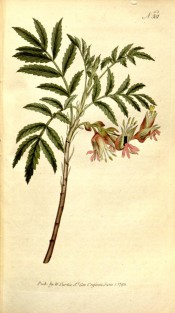Melianthus minor L.
Similar to Melianthus major L., which see, but less robust, downy rather than smooth, leaves to about 20cm, and red-black flowers in racemes to 40cm long. To 2m. [RHSD, Hortus].
Horticultural & Botanical History
‘There are few flowers that do not secrete from some kind of glandular substance, honey, or nectar, to a greater or smaller amount; in those of the present genus, this liquid is particualarly abundant, even dropping from the flowers of the major, in considerable quantity; in the present species it flows not so copiously, but is retained in the lowest part of the blossom, and is of a dark brown colour, an unusual phenomenon. There are only two species of the genus described, the major and the minor, both of which are cultivated in our nurseries; the major is by far the most common, the most hardy, and the most ornamental plant. […] It is a native of the Cape, and, according to Mr. Aiton, was cultivated by the duchess of Beaufort, in 1708; is propagated readily by cuttings.’ [BM t.301/1795]. The RHS Dictionary (1951) considers the plant figured in the Botanical Magazine to be Melianthus comosus Vahl rather than M. minor.
History at Camden Park
Listed in all published catalogues [T.674/1843].
Notes
Published Mar 21, 2009 - 05:19 PM | Last updated Mar 24, 2010 - 03:16 PM
| Family | Melianthaceae |
|---|---|
| Category | |
| Region of origin | South Africa |
| Synonyms | |
| Common Name | Lesser Honey bush |
| Name in the Camden Park Record | Melianthus minor |
| Confidence level | high |


